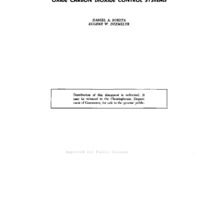-
Title
-
Configuration Investigation for Lithium Oxide Carbon Dioxide Control Systems
-
Date
-
1967
-
Index Abstract
-
Not Available
-
Photo Quality
-
Complete
-
Report Number
-
AMRL TR 67-62
-
Creator
-
Boryta, Daniel A.
-
Dezmelyk, Eugene W.
-
Corporate Author
-
Foote Mineral Company Research and Engineering Center
-
Laboratory
-
Aerospace Medical Research Laboratories
-
Extent
-
159
-
Identifier
-
AD0663762
-
Access Rights
-
Distribution of this document is unlimited. It may be released to the Clearinghouse, Department of Commerce, for sale to the general public.
-
Distribution Classification
-
1
-
Contract
-
AF 33(615)-3382
-
DoD Project
-
6373
-
DoD Task
-
637302
-
DTIC Record Exists
-
Yes
-
Distribution Change Authority Correspondence
-
None
-
Distribution Conflict
-
No
-
Abstract
-
The bulk density of lithium oxide shapes and granules has been increased substantially while retaining good reactivity. Absorbent forms of the oxide can be prepared in the bulk density range of 0.18 to 0.28 g/cc. For granular oxide, results indicate a reasonable compromise between reactivity and absorbent volume efficiency is about 0.20 g/cc in passive systems and 0.26 to 0. 28 g/cc in semipassive or dynamic systems. The improvement results from use of high (about 18 m sq/g) surface area lithium peroxide raw material and techniques in processing the peroxide to oxide. Tests indicate the oxide forms developed can equal (passive exposure) or exceed (semipassive or dynamic exposure) the 0.8 g CO2/g LiOH capacity of granular lithium hydroxide before 2% breakthrough. Dusting of the granular oxide form was reduced by controlled abrasion and fabric encasement techniques. Tests at one-third and normal atmospheres indicated higher carbon dioxide absorption rates at the lower pressure. A marked improvement was found in oxygen-helium as compared to oxygen and oxygen-nitrogen atmospheres. Atmospheric moisture conditions required for efficient absorption were defined. Exploratory work indicates partial hydration of the oxide is one method for initiating absorption under low humidity conditions. Gravimetric analysis work, which confirmed that density limitations are presently imposed by reaction product-substrate molar volume relations, should provide useful guidelines for absorbent design and further experimentation.
-
Report Availability
-
Full text available
-
Date Issued
-
1967-10
-
Provenance
-
RAF Centre of Aviation Medicine
-
Type
-
report
-
Format
-
1 online resource
 AMRLTR67-062.pdf
AMRLTR67-062.pdf